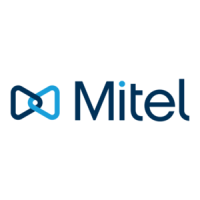Mitel 3000
Installation & Maintenance Manual
40
T1/E1 Module on the Mitel 3000
The Mitel 3000 can be equipped with a T1/E1 PRI Module providing a T1 Robbed Bit Signaling (RBS) or PRI
(T1/E1)ISDN interface.
When the module is installed and the system is powered up the module is detected.
NOTE: If the module is installed while the system is powered up the switch must be reset before the module is
detected.
The default setting is that the module is programmed as a T1 (RBS) circuit with 24 channels. All channels are set
as type E&M, wink start. None of the services described below are set.
It is recommended that the programming of the T1/PRI be carried out through the MPS. This is recommended
purely because the programming can be complex and it is easier to do through the MPS.
TI (RBS) Settings
A number of settings are programmable for each individual channel. The programming of these options must
match the line and service type supplied by the Telephone Company on each channel.
When a T1 / PRI module is programmed as a T1 (RBS) channels can be programmed as E&M, DID, Loop Start
or Ground Start. See page
110 for the programming from the programming telephone.
E&M Type
The E&M type provides two way calling.
A number of start types, Wink, Immediate, Delay Dial and Dial Tone are available.
The setting should be selected to match the type supplied by the Telephone Company. Programming of the start
types from the programming position is explained on page
111.
The service types ANI, DNIS, *ANI*, *DNIS* and *ANI*DNIS* are available. Again the programming of the
service type should match the service provided by the Telephone Company. The default is that no service type is
set. The programming is described on page
110.
DID TYPE
This is an E&M circuit that provides incoming calls only. The start types available on DID lines are Wink,
Immediate and Delay Dial.
The setting should be selected to match the type supplied by the Telephone Company. For programming from the
programming position see page
111.
The service types ANI, DNIS, *ANI*, *DNIS* and *ANI*DNIS* are available. Again the programming of the
service type should match the service provided by the Telephone Company. The default is that no service type is
set. The programming is described on page
110.
Loop Start Type
This type provides two way calling.
The only service available is Caller ID provided using modem tones (FSK). The programming for Caller ID
Detection is shown on page
110. The default is that Caller ID is not programmed.
NOTE: If Caller ID is programmed ON and the service is not available on the lines, the switch will attempt to
detect the Caller ID on all incoming calls. It will only route the call and start ringing phones when it has failed to
detect the Caller ID. This will delay the ringing by a number of seconds. The Line led will appear red while the
switch tries to detect the Caller ID and will change to green when the call starts to ring the telephone. It is highly
recommended that the Caller ID be turned off when no Caller ID is provided on the lines so that calls are dealt
with more efficiently.
Ground Start Type
This type provides two way calling.
There are no services programmable for Ground Start Lines

